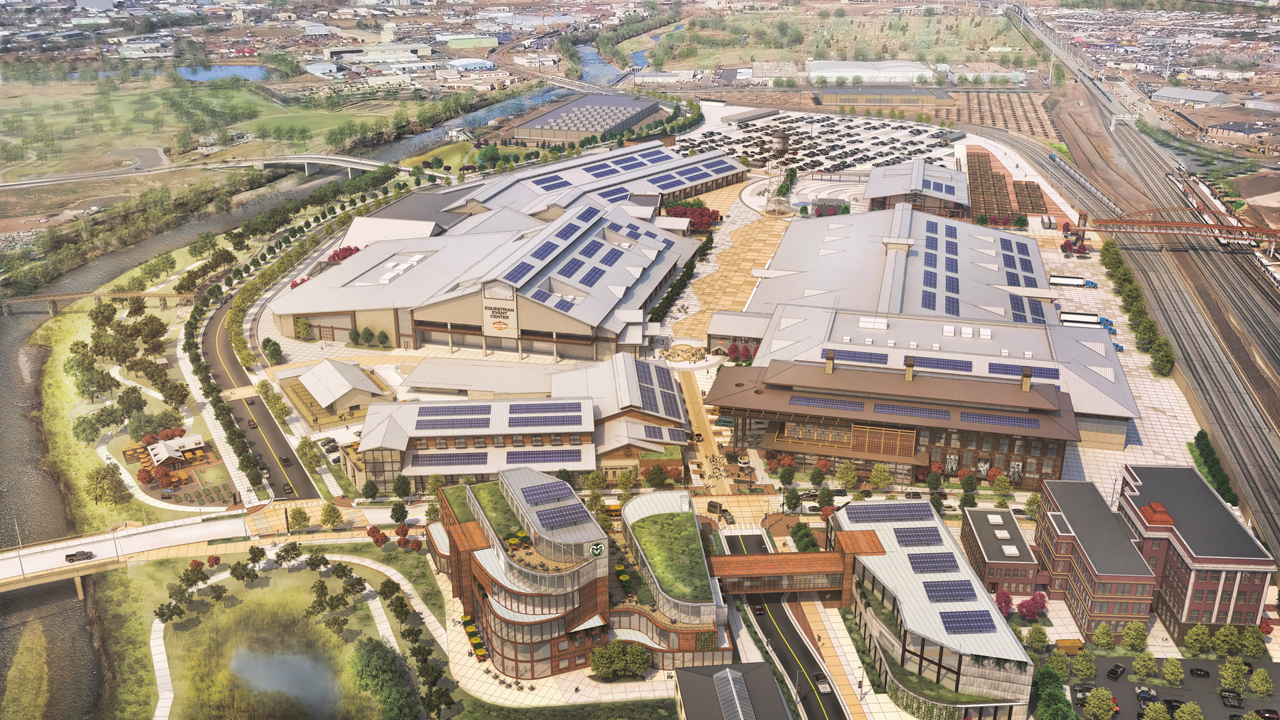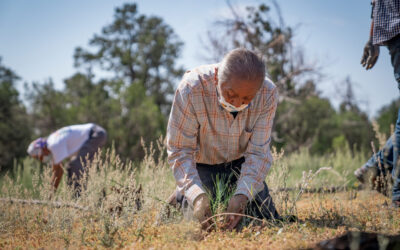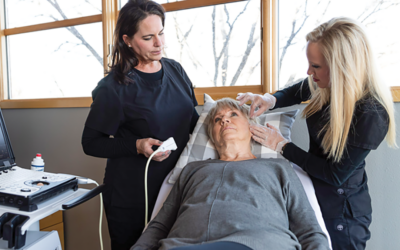At about 250 acres, the National Western project is one of the nation’s largest urban redevelopment ventures. | Image by MIG, courtesy Mayor’s Office of the National Western Center.
CSU prepares to plow new ground at the
National Western Stock Show
by Larry Borowsky
After more than five years of planning, work has finally commenced on the National Western Stock Show redevelopment project in Denver. As one of the lead partners, Colorado State University has a lot at stake in this initiative, which is expected to cost roughly $1 billion – that’s billion with a “b” – when all is said and done. NOCO Style consulting editor Larry Borowsky sat down with CSU Executive Vice Chancellor Amy Parsons to get up to speed on the state of the project and find out how NOCO stands to benefit.
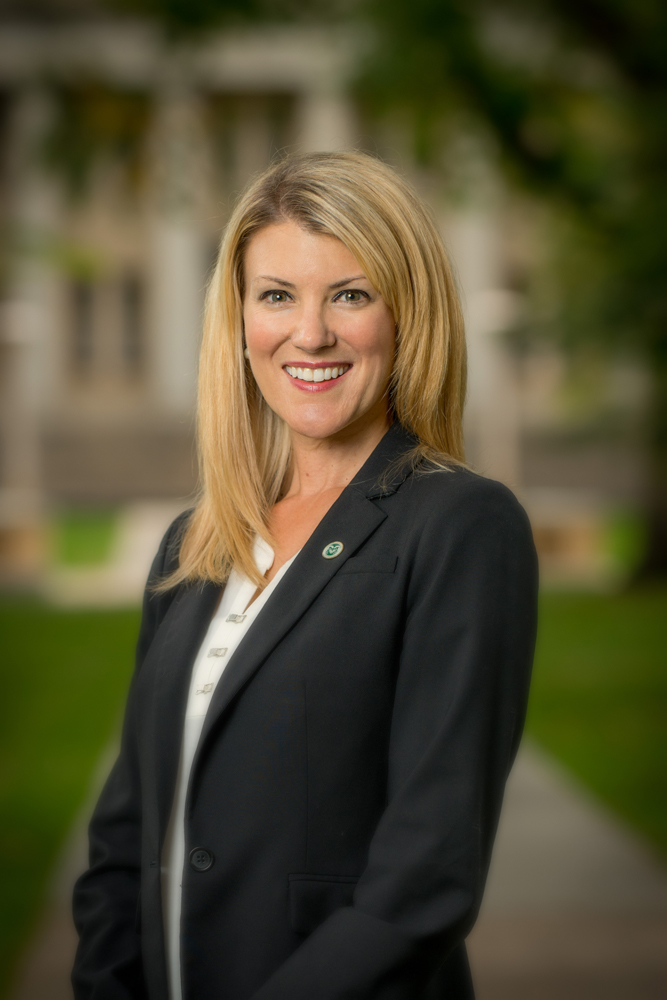
CSU Executive Vice Chancellor Amy Parsons | Photo courtesy Colorado State University
“It’s creating agriculture that’s more sustainable and efficient, but also creating new, different kinds of products and new foods.”
Not a lot of people understand what agriculture is today, how many different industries it affects, and how important the ag innovation economy is to Colorado. We did a study a few years ago looking at where agricultural innovation is happening, and we found that it’s not so much out in the rural areas of the state – it’s right along the Front Range. That’s where new innovations along the food-and-agriculture value chain are happening – new inventions, new patents, new companies, new startups. We are working on great global challenges of how to feed and sustain a growing worldwide population. That’s a really important story to tell.
How are you telling it?
We’re building three separate buildings: the Food and Agriculture building, the Water building, and the Animal Health building. All of our buildings have the dual mission of educating the public about food, water, agriculture and energy, while providing a home for really impactful CSU work in these areas – for researchers, for policy work, for hands-on learning for our students.
Why build these facilities in Denver as opposed to
Fort Collins?
This is a very active public site with tourists, eventgoers, K-12 students, families, people who’ve just arrived at DIA who are coming into the city for the first time. Every day of the week, every week of the year, people will be walking in from across the world and seeing what’s happening in Fort Collins. So it’s a unique opportunity to talk about the great work we’re doing.
Economic development is a big driver of this. Northern Colorado is growing faster than anywhere else. We want to use this as a tool to both grow our existing companies, and to recruit new companies who want to be part of this ecosystem, who want to be close to our researchers, to be close to the heart of the action all up and down the Front Range. We want to create a place where, whether it’s a startup or a company that needs to accelerate, they can work with us for a period of time, have access to some of our researchers, our bench space, our lab space, and incubate their ideas. That will automatically benefit Northern Colorado.
Characterize these companies for me – both the ones that are already here and the ones you’re hoping to attract.
They’re knowledge-based or technology-based companies that help make agriculture more efficient, more sustainable, more profitable. And they’re also creating new products – for example, the drone technology that is related to precision irrigation. They have stakes in the ground that give information to a drone that says exactly when an area should be watered and how much. So you’re watering at the most effective time during the day, and with just the amount of water that’s needed, rather than using the pivot system that’s watering everything in the same amount at the same time. Getting smarter about irrigation saves a ton of water.
So it’s creating agriculture that’s more sustainable and efficient, but also creating new, different kinds of products, new foods, replacing plastics with plant-based products, detecting biohazards and biothreats, things of that nature. Colorado really is a hotbed for innovation in agriculture. We want more of those companies to move to Northern Colorado, and we want to grow the companies that are already here along the Front Range.
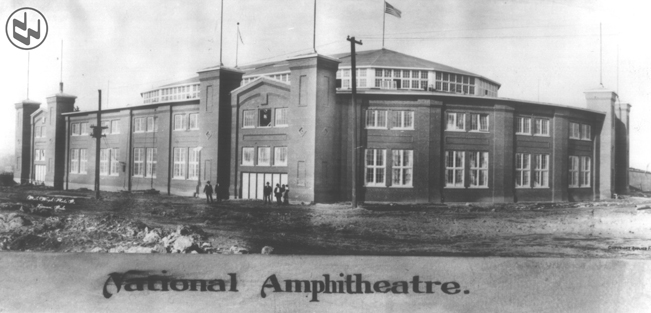
CSU’s partnership with the Stock Show dates back to 1906, two years before the National Amphitheatre was built. | Photo courtesy Colorado State University
Hopefully we’re growing a student population that will go to Fort Collins and study in these various disciplines. Whether they come from out of state or wherever they come from in the world, a lot of them stay and work in Northern Colorado. We need to grow the local work force and inspire our kids to go into this. We want every K-12 student in the state walking through these buildings. We want them to be inspired by these issues and the role they can play in the solutions, whether it’s food, water, agriculture, sustainability. We need everybody to focus on seeing this as their future.
Kids who are going into college and thinking about their future career are really interested in meaningful work and going into professions that are going to make a difference. If you look at our College of Agriculture, over the last 10 years the makeup of students has completely shifted from males who come from rural backgrounds to more females from urban areas. Young women are seeing this as an area where they can really make a difference in the world. It’s important to understand how we’re going to sustainably feed a growing population of 9 billion people. How do we do that with clean water? How do we do that with clean energy? How do we do that in a sustainable, healthy way? It’s going to take a lot of innovation.
And the flip side of that is that most of the major ag companies, especially in the U.S., can’t find enough workers. They have huge numbers of unfilled jobs. So if you want to go into a profession where there are good jobs waiting for you, where you can actually make a difference in solving some of the globe’s most pressing global problems, this is the place to go.
How did CSU get brought in as a partner on the Stock Show project?
CSU has been associated with the Stock Show since the very beginning, 113 years ago. Back then CSU was Colorado A&M, and our students would come down every year to participate in the Stock Show and show their own animals. The university would close to allow all of the students to come to Denver. Our faculty would participate, and we shared board members. So we’ve been an important partner since the very beginning.
Maybe five years ago, Mayor[Michael] Hancock made the commitment to invest in new facilities. So we started thinking about leveraging our ties and our rich history on the site, and how we could add value by being the anchor tenant on this major redevelopment.
What’s the current state of the project?
Demolition is underway on the site. About a year from now, we’ll be going vertical on all three of our buildings. It’s a complicated site, with railroads and rivers and environmental remediation and old buildings and things that have to be really carefully considered as we do a rebuild. A lot of that work is happening in 2019. And then, because the Stock Show has to happen every year in January, work stops [in January 2020] so the Stock Show can happen in the existing facilities, and then we get back to work. We’re planning to do a groundbreaking ceremony during next year’s Stock Show. As soon as that’s over, we can actually start to go vertical.
Are there any existing facilities elsewhere in the country that you’re using as a model for what you’re trying to create at National Western?
There’s nothing quite like this – nothing that has a university in the middle of it, that has turned itself inside out to be a public-facing venue. One place I’ve looked to for inspiration in New York is the Highline Canal and Meatpacking District. Historically, this was a very gritty, urban industrial area, and there still are active meatpacking plants there. I think there’s five or so active plants. But over time, cultural institutions have moved into this place. There are museums there now, and retail, and residential. It’s a place that has really intentionally kept its heritage, similar to what we’re doing at National Western, while allowing modern amenities to develop all around it.
That’s the beauty of this project. It’s that diverse, intense mixture of history along with very modern technology, laboratories and cultural institutions that will turn it into a 365-day-a-year area.

